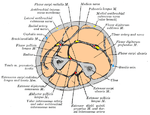Forearm
| Forearm | |
|---|---|
 The forearm is highlighted in magenta | |
| Details | |
| Identifiers | |
| Latin | antebrachium |
| MeSH | D005542 |
| TA98 | A01.1.00.024 |
| TA2 | 146 |
| FMA | 9663 |
| Anatomical terminology | |
The forearm is the region of the
The forearm contains two long bones, the radius and the ulna,[2] forming the two radioulnar joints. The interosseous membrane connects these bones. Ultimately, the forearm is covered by skin, the anterior surface usually being less hairy than the posterior surface.
The forearm contains many muscles, including the flexors and extensors of the
The radial and ulnar arteries and their branches supply the blood to the forearm. These usually run on the anterior face of the radius and ulna down the whole forearm. The main superficial veins of the forearm are the cephalic, median antebrachial and the basilic vein. These veins can be used for cannularisation or venipuncture, although the cubital fossa is a preferred site for getting blood.
Structure
Bones and joints
The bones of the forearm are the radius (located on the lateral side) and the ulna (located on the medial side)

Radius
Proximally, the head of the radius articulates with the
Distally, it articulates with the ulna again at the
at its medial aspect.Ulna
Proximally, the
Distally it forms part of the distal radioulnar joint and also articulates with the wrist.[5]
Muscles
| Compartment | Level | Muscle | E/I | Nerve |
|---|---|---|---|---|
| Anterior | superficial | flexor carpi radialis |
E | median |
| Anterior | superficial | palmaris longus |
E | median |
| Anterior | superficial | flexor carpi ulnaris |
E | ulnar |
| Anterior | superficial | pronator teres |
I | median |
| Anterior | superficial (or intermediate) | flexor digitorum superficialis (sublimis) |
E | median |
| Anterior | deep | flexor digitorum profundus |
E | ulnar + median |
| Anterior | deep | flexor pollicis longus |
E | median |
| Anterior | deep | pronator quadratus |
I | median |
| Posterior | (see below) | brachioradialis | I | radial |
| Posterior | superficial | extensor carpi radialis longus |
E | radial |
| Posterior | superficial | extensor carpi radialis brevis |
E | radial |
| Posterior | intermediate | extensor digitorum (communis) |
E | radial |
| Posterior | intermediate | extensor digiti minimi (proprius) |
E | radial |
| Posterior | superficial | extensor carpi ulnaris |
E | radial |
| Posterior | deep | abductor pollicis longus |
E | radial |
| Posterior | deep | extensor pollicis brevis |
E | radial |
| Posterior | deep | extensor pollicis longus |
E | radial |
| Posterior | deep | extensor indicis (proprius) |
E | radial |
| Posterior | deep | supinator |
I | radial |
| Posterior | deep | anconeus |
I | radial |
- "E/I" refers to "extrinsic" or "intrinsic". The intrinsic muscles of the forearm act on the forearm, meaning, across the elbow joint and the supination), whereas the extrinsic muscles act upon the hand and wrist. In most cases, the extrinsic anterior muscles are flexors, while the extrinsic posterior muscles are extensors.
- The brachioradialis, flexor of the forearm, is unusual in that it is located in the posterior compartment, but it is actually in the anterior portion of the forearm.
- The posterior compartment of the arm.[6]
Nerves
- See separate nerve articles for details on divisions proximal to the elbow and distal to the wrist; see Brachial plexus for the origins of the median, radial and ulnar nerves.
- FDS).
- PQ).
- ECRB).
- FDP).
Vessels

Other structures
Function
The forearm can be brought closer to the upper arm (
Clinical significance

A
For treatment of children with torus fractures of the forearm splinting appears to work better than casting.[7] Genetically determined disorders like hereditary multiple exostoses can lead to hand and forearm deformities. Hereditary multiple exostoses is due growth disturbance of the epiphyses of the radius and ulna, the two bones of the forearm.[8]
Additional images
See also
- Forearm flexors
References
- ISBN 978-0-544-18897-6.
- ^ "Forearm". The Lecturio Medical Concept Library. Retrieved 2021-06-22.
- ^ Mitchell, Brittney; Whited, Lacey (2020-08-15). "Anatomy, Shoulder and Upper Limb, Forearm Muscles". National Center for Biotechnology Information, U.S. National Library of Medicine. StatPearls Publishing LLC. Retrieved 22 June 2021.
- ^ "Structure of The Forearm". The Lecturio Medical Concept Library. Retrieved 2021-06-22.
- ^ )
- ^ "Dissector Answers — Axilla & Arm". The University of Michigan. Archived from the original on 3 January 2008. Retrieved 2008-01-17.
- S2CID 25796224.
- PMID 29565244.




